Gerbera Daisy or Transvaal Daisy, which is scientifically known as Gerbera jamesonii, is a popular and colorful flowering plant that belongs to the Asteraceae family. Native to South Africa, Gerbera daisies have become one of the most widely cultivated and beloved ornamental flowers globally. These cheerful and vibrant blooms are known for their striking appearance and long-lasting flowers. They are tender perennials but are often treated as annuals in cooler climates. In areas with mild winters, they may behave as short-lived perennials.
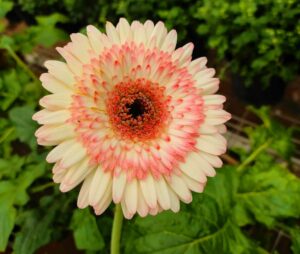
Gerbera daisies are often associated with happiness, innocence, and purity. They make popular choices for gift-giving, particularly to convey positive emotions. Gerbera daisies are popular as cut flowers in floral arrangements, bouquets, and various decorative displays. They are often used in celebrations and events due to their vibrant colors and long vase life.
The plant features basal rosettes of dark green, lobed leaves with a slightly hairy texture. The leaves arise directly from the base of the plant. Depending on the variety, Gerbera daisies can reach a height of about 8 to 24 inches (20 to 60 cm). They are generally compact, making them suitable for both garden beds and containers.
Gerbera daisies are characterized by large, daisy-like flowers with a prominent central disk surrounded by colorful petals. The petals can be single or double, and they come in a wide range of colors, including red, pink, orange, yellow, and white.
Gerbera jamesonii is a versatile and delightful flower that brings a burst of color to gardens, landscapes, and indoor settings. With their charming appearance and a broad spectrum of colors, Gerbera daisies have earned a special place in the world of floriculture.
Sunlight Requirement
Gerbera jamesonii, or Gerbera daisy, generally prefers a location with plenty of sunlight, making it well-suited for bright and sunny conditions. Gerbera daisies thrive in full sunlight. Aim to provide them with at least 6 to 8 hours of direct sunlight each day. In regions with cooler climates, they can tolerate more sunlight. While Gerbera daisies benefit from full sun, they particularly appreciate morning sunlight. In areas with hot climates, providing some protection from intense afternoon heat can be beneficial. Partial shade during the hottest part of the day may help prevent stress on the plants.

When grown indoors, place Gerbera daisies in a location with bright, indirect sunlight. South or west-facing windows are typically suitable. Supplemental lighting may be necessary if natural light is insufficient. If you’re growing Gerbera daisies in containers, ensure they are positioned in a location that receives adequate sunlight. Placing containers on a sunny patio or balcony is a good option.
Temperature and Humidity Requirement of Gerbera Daisy
Gerbera daisies prefer moderate temperatures. The ideal daytime temperature range is between 65°F to 75°F (18°C to 24°C). Cooler nighttime temperatures, ideally between 50°F to 55°F (10°C to 13°C), are beneficial for Gerbera daisies. They often appreciate a temperature drop during the night. In regions with colder winters, Gerbera daisies may benefit from protection during frost. Mulching around the base of the plants can help insulate the roots. While Gerbera daisies thrive in moderate temperatures, they may struggle in extreme heat. Protect them from prolonged exposure to temperatures above 80°F (27°C), especially in hot climates.
Gerbera daisies prefer moderate humidity levels. They can tolerate a range of humidity but avoid excessively dry conditions. When growing Gerbera daisies indoors, maintain a comfortable indoor humidity level. They generally adapt well to the typical humidity levels found in homes.
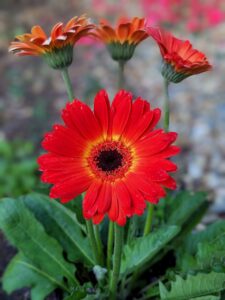
Soil Requirement of Gerbera Daisy Flower
Gerbera daisies prefer well-draining soil to prevent waterlogged conditions. Sandy loam or loamy soil with good drainage is ideal. Heavy or clayey soils should be amended to improve drainage. The recommended soil pH for Gerbera daisies is slightly acidic to neutral, ranging from 6.0 to 6.5. Incorporating organic matter into the soil is beneficial for Gerbera daisies. Gerbera daisies are sensitive to waterlogged soil, which can lead to root rot. Ensure that the soil provides adequate drainage, especially in regions with heavy rainfall. In areas with heavy or poorly draining soils, consider planting Gerbera daisies in raised beds to improve drainage and prevent waterlogging.
When growing Gerbera daisies in containers, use a well-draining potting mix designed for flowers or perennials. Container mixes with perlite or vermiculite work well to maintain good aeration and drainage.

Propagation of Gerbera Daisy Flower
Gerbera jamesonii, or Gerbera daisy, can be propagated through various methods, including seeds, division of established plants, and sometimes through offshoots.
Propagation from Seeds
Start Gerbera daisy seeds indoors, about 8 to 10 weeks before the last expected frost date. Sow the seeds on the surface of a seed-starting mix and lightly press them into the soil. Cover the seeds with a thin layer of soil and mist the surface. Place the container in a warm location (around 70°F or 21°C) and keep the soil consistently moist. Germination usually occurs within 7 to 21 days. Once the seedlings have a couple of true leaves, transplant them into individual pots. After the last frost, transplant the seedlings into well-prepared garden soil or containers.
Division of Established Plants
The division is best done in early spring or early fall. Carefully dig up an established Gerbera daisy plant, taking care not to damage the roots. Gently separate the plant into sections, ensuring each section has roots and shoots. Plant the divisions in well-prepared soil at the same depth they were originally growing. Water thoroughly after planting.
Offshoots or “Pups”
Some Gerbera daisies produce offshoots or “pups” around the base of the plant. Once the offshoots have developed roots and are large enough to handle, carefully separate them from the parent plant. Plant the separated offshoots in a new location or container, ensuring they receive proper care and watering.
Water Requirements
Proper watering is crucial for the health and well-being of Gerbera jamesonii (Gerbera daisy). Gerbera daisies prefer consistently moist soil. It’s important to keep the soil evenly moist, especially during the growing season and when the plants are actively producing flowers. While Gerbera daisies like moist conditions, they are susceptible to root rot if the soil becomes waterlogged. Watering in the morning is generally recommended. When possible, avoid overhead watering, especially if you’re growing Gerbera daisies in a location with limited air circulation. Watering at the base of the plant helps keep the foliage dry and minimizes the risk of diseases.
If growing Gerbera daisies in containers, check the moisture level regularly. Containers can dry out more quickly than garden soil, so frequent monitoring is essential. Ensure that containers have drainage holes to prevent waterlogging. While Gerbera daisies prefer consistent moisture, they do have some tolerance for brief periods of drought. However, extended dry periods can lead to stress and affect flowering.

Fertilizer Requirement of Gerbera Daisy
Gerbera jamesonii (Gerbera daisy) benefits from regular fertilization to support healthy growth and prolific flowering. Use a balanced, all-purpose fertilizer with equal or near-equal amounts of nitrogen (N), phosphorus (P), and potassium (K). A general-purpose granular fertilizer with a balanced N-P-K ratio, such as 10-10-10 or 14-14-14, is suitable. Consider using a slow-release fertilizer to provide a steady supply of nutrients over an extended period.
Apply a balanced fertilizer when planting Gerbera daisies or when they start actively growing in the spring. This initial application provides the necessary nutrients for establishing healthy roots and foliage. During the growing season, typically from spring to early fall, feed Gerbera daisies every 4-6 weeks. While nitrogen is essential for foliage development, too much nitrogen can result in excessive vegetative growth at the expense of flowers. Avoid overusing high-nitrogen fertilizers. Potassium is important for flower development. Choose a fertilizer with an adequate amount of potassium to encourage robust flowering.
If growing Gerbera daisies in containers, they may require more frequent fertilization. Container plants rely on the nutrients present in the potting mix, which can deplete over time.
Deadheading of Gerbera Daisy Flower
Deadheading is a common practice in gardening that involves removing spent or faded flowers from a plant. This process helps redirect the plant’s energy away from seed production and encourages it to produce new blooms. When it comes to Gerbera jamesonii (Gerbera daisy), deadheading is a beneficial care practice.
Monitor your Gerbera daisy plants regularly to identify flowers that have wilted, faded, or lost their vibrancy. Use your fingers or sharp scissors/pruning shears to pinch or cut the spent flower stem just above the base of the stem or where it connects to the main stem of the plant. Continue deadheading throughout the growing season, especially during periods of active blooming. Regular deadheading encourages the production of new flower buds and prolongs the overall flowering period. Removing faded flowers enhances the overall appearance of the plant, keeping it tidy and visually appealing.
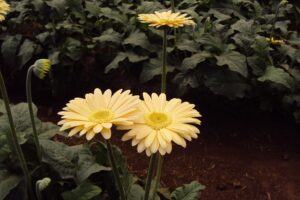
Problems While Growing Gerbera Jamesonii Flower
While Gerbera jamesonii (Gerbera daisy) is generally a hardy and resilient plant, several common problems may arise during its cultivation.
Fungal Diseases: Gerbera daisies can be susceptible to fungal diseases, such as powdery mildew and leaf spot, especially in humid conditions. Ensure proper air circulation by providing adequate spacing between plants. Avoid overhead watering, and apply fungicides as a preventive measure or when symptoms appear.
Pests: Aphids, spider mites, and whiteflies are common pests that can affect Gerbera daisies. Monitor plants regularly for signs of pests. Use insecticidal soap or neem oil to control minor infestations. Natural predators like ladybugs can also help keep pest populations in check.
Root Rot: Waterlogged soil can lead to root rot, especially if the plant’s roots are consistently in contact with excess moisture. Ensure well-draining soil, and avoid overwatering. Plant Gerbera daisies in containers with drainage holes. Provide proper spacing between plants to prevent waterlogging.
Yellowing Leaves: Yellowing leaves can be caused by various factors, including nutrient deficiencies, overwatering, or poor soil drainage. Adjust watering practices, ensuring the soil is consistently moist but not waterlogged. Fertilize with a balanced fertilizer to address nutrient deficiencies. Check for proper soil drainage.
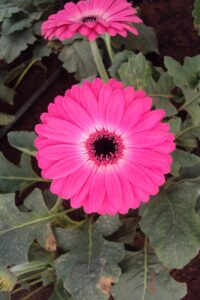
Bud Blast: Bud blast occurs when flower buds fail to open and instead wither before blooming. This can be due to environmental stress or fungal issues. Maintain consistent growing conditions, including proper sunlight, temperature, and moisture levels. Address fungal problems promptly.
Poor Flowering: If Gerbera daisies are not blooming as expected, it could be due to inadequate sunlight, over-fertilization with high nitrogen, or crowded growing conditions. Ensure the plants receive sufficient sunlight (at least 6-8 hours of direct sunlight). Adjust fertilization to avoid excessive nitrogen. Thin out crowded areas to improve air circulation.
Regular monitoring, prompt action when problems arise, and providing optimal growing conditions can help prevent and address many issues while growing Gerbera jamesonii.
Ornamental Uses of Gerbera Daisy Flowers
Gerbera daisy is widely appreciated for its vibrant and colorful blooms, making it a popular choice for ornamental purposes. Here are some of the ornamental uses of Gerbera jamesonii:
Cut Flowers: Gerbera daisies are one of the most popular cut flowers, known for their large, colorful blooms and long stems. They are commonly used in floral arrangements, bouquets, and as single-stem cut flowers in vases.

Garden Borders and Beds: Planted in garden borders and beds, Gerbera daisies add a burst of color and a cheerful, lively presence to the landscape. They are often used as a focal point or in combination with other flowering plants.

Container Gardening: Gerbera daisies are well-suited for container gardening. Planted in pots, containers, or hanging baskets, they can be placed on patios, balconies, or porches, providing a colorful display in small spaces.
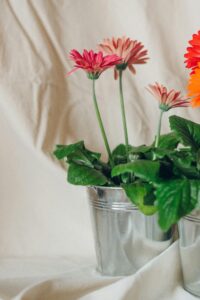
Landscaping: In landscaping projects, Gerbera daisies are employed to create eye-catching flower beds, adding visual interest to lawns, parks, and public spaces.
Floral Gifts: Gerbera daisies are commonly included in floral bouquets and arrangements given as gifts for various occasions, such as birthdays, anniversaries, and celebrations.

Events and Celebrations: Gerbera daisies are frequently used in event decor, such as parties, receptions, and corporate functions. Their lively colors and large blooms make them a popular choice for creating a festive atmosphere.
Floral Craftwork: The colorful petals of Gerbera daisies can be used in various floral craft projects, including pressed flower art, floral wreaths, and other DIY arrangements.

Butterfly and Pollinator Gardens: The nectar-rich flowers of Gerbera daisies attract pollinators like butterflies, making them a valuable addition to butterfly gardens and landscapes designed to support pollinator populations.
Overall, the ornamental uses of Gerbera jamesonii are diverse, and their versatility in various settings makes them a cherished flower for both professional florists and home gardeners alike.


